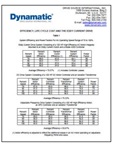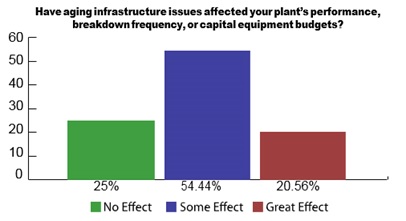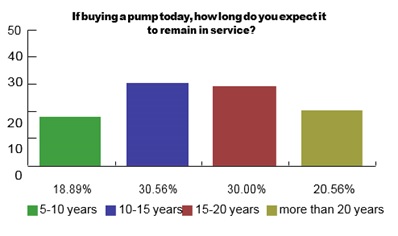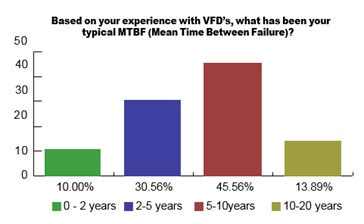American municipalities face aging infrastructure problems in almost every aspect of their services to citizens – from roadways, electrical distribution, water & sewer distribution to collection and treatment processes. As we work across the country to rebuild and upgrade municipal pumping stations, we have to make a concerted effort to install equipment that has been proven to operate reliably. When reviewing the reliability of VFD’s compared to Eddy Current Drives, it is clear that Eddy Current Drives defy the trend of early obsolescence. Variable frequency pumping equipment in treatment plants and pumping stations can be especially vulnerable to early failure due to the ‘repair-or-replace’ dilemma. Repairs can be impractical due to obsolescence on the part of the component manufacturers or equipment manufacturers. Recognizing this weak link in the reliability and ownership cost of variable speed pumping equipment, a significant number of specifiers and users have shown interest in alternatives to variable frequency drives. A recent survey of over 200 water and wastewater professionals reveals that aging infrastructure is a genuine concern in their industry, with over 75% reporting this to be the case.
Pumps and the electric motors that drive them are generally recognized to be reliable and long lived.
But expectations and experience indicate that variable frequency drives do not live up to the life expectancy of their related driven equipment.
Eddy Current Drive technology is the most Reliable Alternative.
Like the pumps and electric motors that drive them, Eddy Current drives are rotating machines. They are constructed with steel castings, fabrications, bearings, and electrical windings. These drives are easily understood by maintenance and repair personnel with wear parts that are readily available at a reasonable cost. For these reasons, Eddy Current drives are widely found to be in active service for 30, 40, and even 50 years after their initial installation.
In the 1960’s and 1970’s, the Eddy Current variable speed drive was the industry standard choice when variable speed pumps or fans were needed. Thousands of Eddy Current Drives were installed in water treatment, wastewater treatment, booster stations, and lift stations. In the 1980’s, it became popular to replace existing Eddy Current equipment (even when fully operational) with variable frequency drives in the pursuit of a more modern or more efficient system. All too often, though, this idea had been shown to be misguided – especially considering the cost to repair or replace VFDs that fail well before the pump and motor reach the end of their useful life. This has been the case for large horsepower applications requiring medium voltage (2300 or 4160 volt) motors. Variable frequency drives in these applications are large, expensive, and often require space that must be added onto existing buildings that need to be equipped with air conditioning systems that consume more power (Read about the Capital Costs of Drive Options).
Recognizing these factors, users and specifiers are taking a new look at the ‘old’ technology of Eddy Current drives (originally developed in the 1930’s). Existing units in need of repair are being replaced with new units or are being rebuilt to factory specifications, as this will restore them for decades of continued service. Rotating mechanical equipment that is still serviceable can be re-equipped with modern digital controllers that can be easily integrated with SCADA users or with modern digital controllers that can be adapted to operate with any manufacturer’s drive unit by simply changing a few parameters in the digital control – In contrast to VFD’s that can only be repaired with OEM parts that might be unavailable or too expensive to consider. With low maintenance and repair costs, Eddy Current drives have an excellent energy saving approach to variable speed loads such as centrifugal pumps, fans and compressors.
While the problem of aging infrastructure will persist for many aspects of municipal utility operations, Eddy Current Drive solutions can ease the effect in the form of low cost solutions to current problems and long-term avoidance of future trouble.
 DOWNLOAD THE TECHNICAL PAPER: Efficiency, Life Cycle Cost, and the Eddy Current Drive. This technical paper discusses evaluation of life cycle costs, eddy current drive characteristics, drive system acquisition, installation, and operating costs, annual savings comparisons, power factor, downtime, maintenance, and repair costs, and system efficiency.
DOWNLOAD THE TECHNICAL PAPER: Efficiency, Life Cycle Cost, and the Eddy Current Drive. This technical paper discusses evaluation of life cycle costs, eddy current drive characteristics, drive system acquisition, installation, and operating costs, annual savings comparisons, power factor, downtime, maintenance, and repair costs, and system efficiency.
To learn more about Eddy Current drives and their proven track record of long, reliable service life, visit www.dynamatic.com.
About the Author
Gary Patterson holds a BS degree in Electrical Engineering from Michigan Technological University, where he pursued the Power Option, specializing in rotating equipment and electrical power generation, transmission, and distribution. He began his career with a manufacturer of large motors, assigned as a factory application engineer, specializing in the firm’s line of eddy current variable speed drives, and their emerging variable frequency drive technology. He served later as a field sales engineer in Chicago, and eventually assumed regional responsibility. He has worked in field sales as a region manager for a variable frequency drive manufacturer, and has also been employed as a sales engineer with a manufacturer’s representative firm, responsible for a large variety of electrical and mechanical equipment. He presently serves as the Pump, Fan, Compressor Technical Specialist for Dynamatic, focusing on pumping and similar applications in the industrial and municipal markets.








Comments